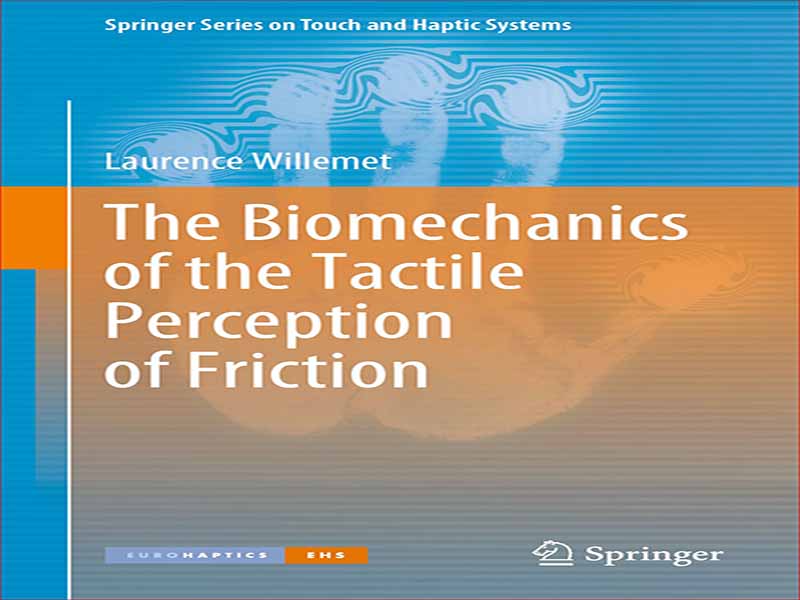- عنوان: The Biomechanics of the Tactile Perception of Friction
- نویسنده: Laurence-Willemet
- حوزه: بیومکانیک
- سال انتشار: 2022
- تعداد صفحه: 139
- زبان اصلی انگلیسی
- نوع فایل: pdf
- حجم فایل: 5.18 مگابایت
هنگام دستکاری اشیا، انسان ها برای درک حرکات ظریف و لغزش های کوچک به حس لامسه خود تکیه می کنند. این هم افزایی بین احساسات و حرکت به آنها اجازه می دهد تا طیف چشمگیری از اجسام با اندازه ها، شکل ها و ویژگی های سطحی مختلف را دستکاری کنند. این مهارت باورنکردنی متکی بر تنظیمات سریع و ناخودآگاه نیروی چنگ است که با قرار دادن یک حاشیه ایمنی 20 درصدی قبل از لیز خوردن، جسمی را به اندازه کافی قوی نگه می دارد تا از سقوط فاجعه بار جلوگیری کند و در عین حال به اندازه کافی ملایم باشد که به آن آسیب نرساند. علاوه بر دقیق بودن، این تنظیم سریع است: تنها صد میلی ثانیه پس از اولین تماس، نیروهای چنگال با در نظر گرفتن قدرت اصطکاک واقعی تماس تنظیم می شوند. این عملکرد شگفتانگیز مرهون حس لامسه است که از ویژگیهای فیزیکی دنیای اطراف و وضعیت تماس خبر میدهد. در نوک انگشت، هزاران گیرنده مکانیکی، تعامل مکانیکی پیچیده را به پتانسیل های عمل تبدیل می کنند. با این حال، اینکه چگونه مغز با حجم زیادی از داده ها برای استنباط وضعیت تماس کنار می آید، هنوز مورد بحث است. این کتاب نشان میدهد که چگونه آوران لمسی پوستی تنظیم سریع و دقیق گرفتن را ممکن میسازد. اولاً، من نشان میدهم که انسانها میتوانند اصطکاک را بدون لغزش ارزیابی کنند، و نشان میدهد که کشش شعاعی پوست میتواند اطلاعات کافی برای تنظیم چسبندگی در شروع تماس فراهم کند. ثانیاً، من نشان میدهم که سیستم ادراکی از یک کد فشرده برای تخمین حاشیه ایمنی ناشی از تغییر شکل پوست در طول یک لغزش اولیه استفاده میکند و مکانیزمی را برای توضیح واکنشهای سریع پیشنهاد میکند. در نهایت، من یک مدل جدید مبتنی بر مکانیک تماس را برای تعیین کمیت حساسیت گیرندههای مکانیکی به الگوهای تغییر شکل پوست که در دو فصل اول برجسته شدهاند، معرفی میکنم. این مدل همچنین آستانه تشخیص مکانی و زمانی را برای تشخیص یک محرک متحرک مرتبط میکند، که نشاندهنده تداوم لمس است که احساسات گسسته را به یک محرک پیوسته پل میکند. روی هم رفته، این نتایج نشان میدهد که چگونه درک اصطکاک در تغییر شکل مکانی-زمانی پوست کدگذاری میشود. این یافته ها برای طراحی حسگرهای لمسی با الهام از زیستی برای روباتیک یا پروتز و برای بهبود تعاملات لمسی ماشین انسانی مفید هستند.
When manipulating objects, humans rely on their sense of touch to perceive subtle movements and micro slippages. This synergy between sensations and motion permits them to manipulate an impressive range of objects of different sizes, shapes, and surface properties. This incredible dexterity relies on fast and unconscious adjustments of the grip force by placing a 20% safety margin before slipping that holds an object strong enough to avoid a catastrophic fall yet gentle enough not to damage it. In addition to being accurate, this regulation is swift: Only a hundred milliseconds after first making contact, grip forces are already adjusted by taking into account the actual frictional strength of the contact. This astonishing performance is owed to the sense of touch, which informs on the physical properties of the surrounding world and contact state. Within the fingertip, thousands of mechanoreceptors convert the complex mechanical interaction into action potentials. However, how the brain copes with large amounts of data to infer the state of the contact is still debated. This book covers how the cutaneous tactile afferent made it possible for a swift and precise regulation of the grip. Firstly, I show that humans can assess friction without slippage, suggesting that the radial stretch of the skin can provide enough information to regulate grip at the contact initialization. Secondly, I show that the perceptual system uses a compact code to estimate the safety margin from the skin deformation during an incipient slip, suggesting a mechanism to explain the rapid reactions. Finally, I expose a new model based on contact mechanics to quantify the sensitivity of the mechanoreceptors to the patterns of skin deformation highlighted in the first two chapters. This model also correlates the spatial and temporal detection threshold to detect a moving stimulus, suggesting a persistence of touch that bridges discrete sensations into a continuous stimulus. Taken together, these results reveal howthe perception of friction is encoded in the spatio-temporal deformation of the skin. The findings are useful for designing bioinspired tactile sensors for robotics or prosthetics and for improving haptic humanmachine interactions.
این کتاب را میتوانید بصورت رایگان از لینک زیر دانلود نمایید.
Download: The Biomechanics of the Tactile Perception of Friction



































نظرات کاربران